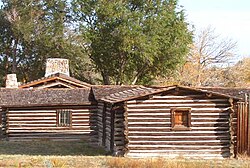Fort Caspar
|
Fort Caspar and Boundary Increase
|
|

Reconstructed buildings at the site of Fort Caspar
|
|
| Location | 14 Fort Caspar Rd. Casper, Wyoming 82604 |
|---|---|
| Coordinates | 42°50′12″N 106°22′16″W / 42.83667°N 106.37111°WCoordinates: 42°50′12″N 106°22′16″W / 42.83667°N 106.37111°W |
| Architect | Louis Guinard |
| NRHP Reference # | 71000887; 76002282 |
| Added to NRHP | August 12, 1971; July 19, 1976 |
Fort Caspar was a military post of the United States Army in present-day Wyoming, named after 2nd Lieutenant Caspar Collins, a U.S. Army officer who was killed in the 1865 Battle of the Platte Bridge Station against the Lakota and Cheyenne. Founded in 1859 along the banks of the North Platte River as a trading post and toll bridge on the Oregon Trail, the post was later taken over by the Army and named Platte Bridge Station to protect emigrants and the telegraph line against raids from Lakota and Cheyenne in the ongoing wars between those nations and the United States. The site of the fort, near the intersection of 13th Street and Wyoming Boulevard in Casper, Wyoming, is listed in the National Register of Historic Places and is now owned and operated by the City of Casper as the Fort Caspar Museum and Historic Site.
The area where Platte Bridge Station was located had been the site of various temporary Army encampments over a period of years before the establishment of the fort, or "station" itself. The fort was located on the south side of the North Platte, near the western edge of present-day Casper, at one several local points where the Emigrant Trail crossed from the south side to the north side of the river. In 1847, during the first Mormon wagon train to present-day Utah, Brigham Young commissioned a ferry at the site for later emigrants. The ferry consisted of cottonwood dugout canoes and planking for a deck, with two oars and a rudder. On June 19, Young named nine men to remain to operate the ferry while the remainder of the party continued the journey westward. A group of Mormons returned to the site each summer between 1847 and 1852 to operate the ferry. The ferry was moved to a different spot on the North Platte in North Casper in 1849. It was eventually replaced with a rope-and-pulley system that could make the crossing in five minutes.
...
Wikipedia
